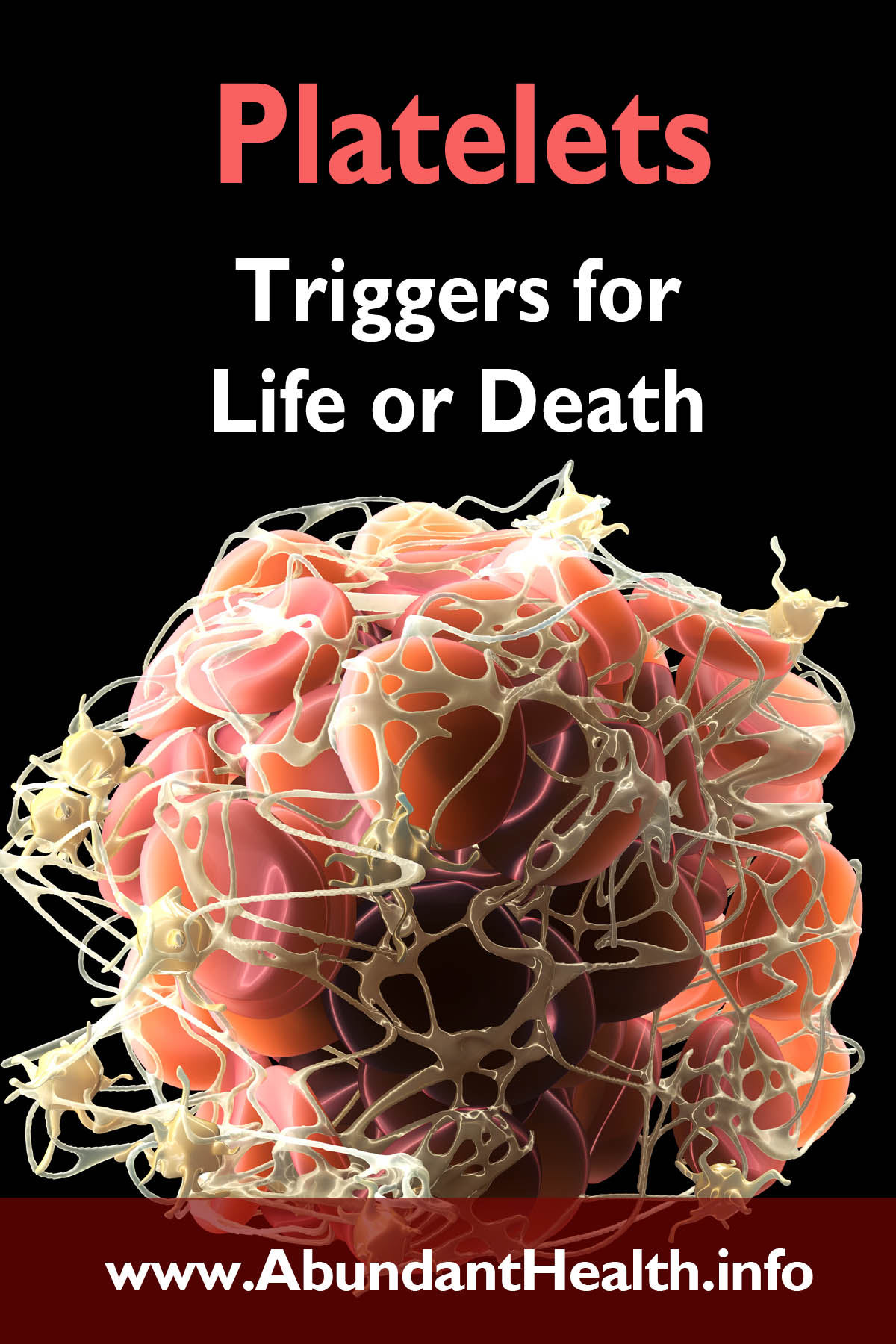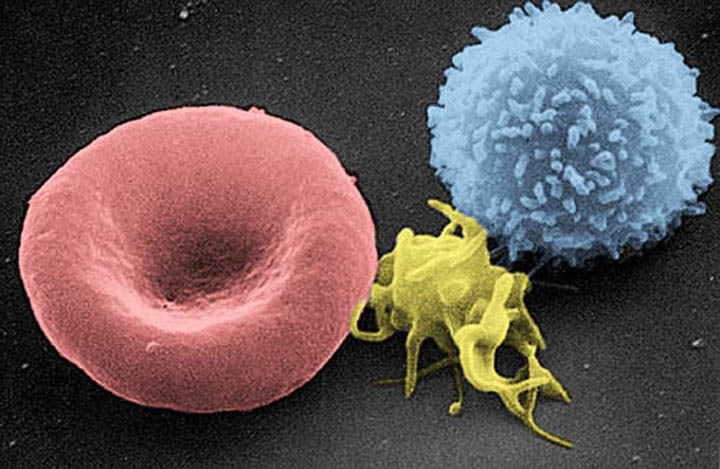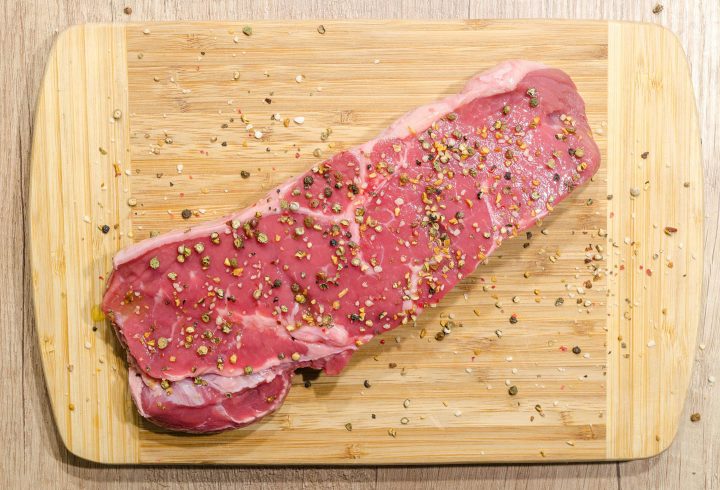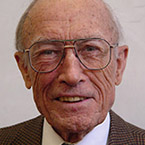President Eisenhower was astonished. Two fitness scientists, Kraus and Webber, had just shown that American young people were flabby. On average, they were less flexible, had less endurance, and were weaker. Being more active, European youth easily outclassed Americans. it got to lke. None of this second-class status for Americans! He would arise and mount a national fitness campaign that would make Americans first in the world for physical fitness. So he flew to Colorado, played 27 holes of golf in one day! Ate a couple of big hamburgers meanwhile. And … got a heart attack that shocked and shook the nation. What triggered a coronary heart attack in this vigorous man? And why, later, did he suffer a stroke that grazed the speech center in his brain? Why? Largely PLATELETS, that’s why.

What are these platelets and why are they so important in heart attacks and strokes? Let’s take a look at the applied physiology of these tiny floating Band-Aids in the blood. We should have about 150,000 to 400,000 of them in every cubic millimeter of our blood. That adds up to about a trillion per person. What are they good for?
They keep us from bleeding to death when we cut ourselves. They go to work instantly to initiate blood clotting. First, they reach out sticky fingers and grab other platelets. Then they lock arms with myriads of other platelets. They also anchor to nearby wounded blood vessels or non-vascular tissues. immediately they eject clot-forming substances that unleash a cascade of enzymatically propelled reactions that change fluid blood into a semi-solid plug laced with a network of fibrin strands to stabilize it. Normally the resulting clot stops the hemorrhage or repairs tiny defects inside any of our blood vessels.
In health, when platelets are not trigger-happy, this clot should be just the right size to deal with the extent of the injury. In combination with healthy blood and normal vessels, balanced platelet function should repair, not ruin.
When platelets are deficient in number or power we may hemorrhage, even bleed to death. And on the other hand, when platelets are excessively stimulated we can get abnormal, even disastrous clotting which produces thrombosis or embolism. Thrombosis is the formation of an abnormal clot within a blood vessel. An embolus is a floating clot, abnormal tissue, or other material. In this case it is a clot that has broken loose from a thrombus, and sails at high speed down the blood vessel to jam in another, narrower, place. Thrombosis is all too common in heart attacks and strokes; excessive platelet function can ruin us for good.
We used to think that high cholesterol constituted the heart-attack problem. No more. True, excess fat, especially animal fat and cholesterol, smoking, high blood pressure, diabetes, or 20 other diseases, deficient exercise, and aging can add up to dangerous plaques that can so narrow the insides of crucial arteries that they make for trouble. But now we realize that the most common cause of the final plugging of a vessel in the heart or brain is a new injury to an already existing plaque. It cracks or splits open, launching an enlarged clot or thrombus that jams the blood vessel shut. This leads all too often to a painful or even deadly heart attack. Because of their crucial role as triggers of coagulation, these mighty little midgets (platelets) are at the center of concern for this role in the deaths of thousands of people and the crippling of millions of others.
What are platelets like?
Off-duty platelets float around in the circulation from eight to twelve days, like smaller leaves in the edge of a stream. But under the microscope, they look like navy beans compared to walnut-sized red blood cells. The more they are studied the more interesting and complicated they become. Full of machinery for starting, sustaining, and anchoring clots, they also have built-in power plants called mitochondria, membrane pumps to stay viable, and projectile-like guns to shoot clotting chemicals at damaged areas. Platelets are also equipped with micro-muscles poised to pull blood vessels or tissues together after they have anchored into them. And then when the emergency is all over and their job is done they contain lysosomes ready to dissolve themselves.

Life spans of platelets
The life span of red blood cells is about 120 days. Platelets live one-tenth as long. By isotopic labeling, we have learned that under the best of conditions human platelets can live 12 days. In smokers they survive only 10 days on average. This means the extra making and handling of about 80 billion platelets per day. If vegetable fat is consumed liberally, survival goes down to nine days. But if animal fat is emphasized, then down to eight days.1)Fitzgerald GA, Jennings LK, and Patrono C, Eds. Platelet-Dependent Vascular Occlusion. The New York Academy of sciences, New York, NY, 1994, pp 1-328.
The spleen should monitor platelet quality. Ideally, if platelets can’t be cleaned up enough for front-line duty they are disassembled. In view of their crucial role, not only in normal clotting or repair of blood vessels, but also their ominous role in life-threatening heart attacks and crippling strokes, there is a most significant question:
How can we keep our platelets cool instead of inflamed?
We can do much to avoid premature or damaging platelet activation by keeping our heads cool. Anger flushes the blood with hormones that irritate platelets. Calm people tend to have calm blood. 2)Wenneberg SR, Schneider RH, et al. Anger on correlates with platelet aggregation (abs). .Behav Med 22(4): 174-177, 1997 Severe stress also can aggravate stickiness of platelets, thus pushing them in the direction of dangerous blood clots.
Tobacco smoke
Either active or passive smoking is poisonous to platelets. These little midgets get angry and ready to fight – too sticky.3)Rama Sastry BV and Gujrati VR. Activation of PAF-Acetylhydrolase by Nicotine and Cotinine and Their Possible Involvement in Arterial Thrombosis. Dept of Anesthesiology and Pharmacology y, Vanderbilt University Medical Center, Nashville, TN 37232-2125, p 312-314 Trouble! There is more than just clotting involved. Platelet-derived growth factor (pDGF) can overdrive cell growth in the walls of coronary arteries over a period of months or years, which pushes overgrowth inside of cholesterol/fat plaques. This overgrowth inside of a coronary artery can strangle its internal diameter, a process called stenosis. In the heart this contributes to pain in the chest or angina pectoris. Recent research has shown that besides platelets, several other cell types can also make pDGF. In any case, keeping platelets cool is a wise objective in healthful living.
Alcohol rebound
When people drink alcohol on the weekend and then sober up to face the week of work, the platelets show ALCOHOL REBOUND. They react by getting too sticky. 4)Ruf JC. Platelet rebound effect of alcohol withdrawal and wine drinking in rats. Relation to tannins and lipid peroxidation (abs). Artherioscler Thromb Vasc Biol 15 (1). 140-4, 1995
Overexertion can be deadly
The New England Journal of Medicine, the most prestigious medical journal in the world, for December 2, 1993 has two lead articles, one first editorial and five letters, all about excessive exercise. They cite over two thousand cases that indicate that jogging or any exercise of six METS or more (one MET, metabolic equivalent = 3.5 ml of oxygen used per kg body weight per minute) is dangerous. They think excess exertion triggers 25,000 heart attacks per year VIA PLATELETS. 5)Mittleman MA, et al. Triggering of Acute Myocardial Infarction by Heavy Physical Exertion. The New Eng J of Med 329- 1677-83, 1993.
Willich SN, et al. Physical Exertion as a Trigger of Acute Myocardial Infarction, The New Eng J of Med 329. 1684-1690, 1993 These authors show that over-exertion doubles heart attack risk in the most fit exercisers, but increases the risk for weekend over-exercisers 120 times. Jogging or overexertion as in snow shoveling, pushing a car by yourself, competitive tennis, basketball, and racquet ball, to mention a few huffing and puffing activities, can kill people by several mechanisms. This newer evidence indicates that overexertion is dangerous, especially to the very people who need exercise the most – those at risk.

Excessive exercise markedly increases the output of hormones that activate platelets. In addition, deficient blood flow to the liver impairs its ability to make a clot-dissolving enzyme called PLASMIN. These two mechanisms add up to a double whammy for the predisposed coronary artery. Marathoners commonly show 300% excess clotting factors in their blood, and have dramatic elevations of platelet counts and adhesiveness. 6)Rock G, Tittley P and Pipe A. Coagulation factor changes following endurance exercise (abs). Clin Sport Med 7 (2). 94-9, 1997.
Tradition claims that the first marathoner died at the conclusion of his run. Modern imitators all too often die in running shoes. Keep your platelets cool!
More moderate exercise can help balance your autonomic nervous system while you are getting your workout for the whole person instead of just your muscles, heart, and lungs. New exercise is whole-person oriented.
Cool diet for cooler platelets
In the still-current and active health laws given by Moses anciently, the Bible declares: “It shall be a perpetual statute for your generations throughout all your dwellings, that YE EAT NEITHER FAT NOR BLOOD.” Leviticus 3:17. And years after Pentecost, and after the first generally assembled conference, chairman James declared to the empowered Holy-Spirit-led New Testament church, “Therefore l judge that we should not trouble those from among the Gentiles who are turning to God, but that we write to them to abstain from things polluted by idols, from sexual immorality, from things strangled, and FROM BLOOD.” Acts 15:19.20 NKJ. Also see verse 29. Today everyone knows the manifold dangers of animal fat, but most eat meat with the blood regularly, not realizing that dead platelets in the meat are dangerous. Platelet Factors 3 and 4 are both thermostable (not destroyed by heat).7)Wintrobe AM, Lee GR, et al. Glinical Hematology. Lea & Febiger, Philadelphia PA, 1974, p 397-398 Even thorough cooking cannot destroy the platelet-inflaming properties of the blood in the meat. Furthermore, tissue juices of animal flesh are dangerous to the delicate balance of blood coagulation.

‘No wonder one meal of meat increases the number AND the stickiness of platelets. 8)Ratnaff OD and Forbes CD. Disorders of Hemostasis, 3rd ed, Saunders, Philadelphia, PA, 1996, p 12. Meat is procoagulant; even kosher meat is highly saturated and cholesterol-laden. Ordinary steaks, chops, chicken, and even fish have the blood left in them for two reasons, flavor and profits. What we need to understand is that to eat blood is a violation of health principles of both Acts 15:20,29 in the New Testament and Leviticus 3:17 of the Old Testament, as well as a serious violation of the physiological laws of hemostasis (maintaining healthful balance of blood coagulation and control of bleeding). Such conventional and presumptuous behavior imagines that our platelets in this stressful world are made of stainless steel, our coronaries are Teflon, and our hearts will never die!
Other factors that can over-stimulate blood clotting are high levels of homocysteine, promoted by inadequate dietary intake of certain vitamins; folate, and sometimes vitamin B-6, or pyridoxine, rarely by B-12. Incriminated also are drinking five or more cups of coffee per day, and by that villain of health – smoking. Combining these risk factors elevates the homocysteine to dangerous levels,9)Best CH and Taylor NB. The Physiological Basis of Medical Practice, The Williams & Wilkins Co, Baltimore, MD, 1950, p 100 and that is not to mention also: obesity, hypertension, blood sludging, trauma, foreign or otherwise damaged or eroded surfaces, inflammation, and of course imbalances in coagulation factors. These powerful substances must always be kept in check and balance, otherwise an avalanche of coagulation can strike in the most vulnerable of places – heart or brain.
Summary
It is becoming more obvious by the month, that President Eisenhower probably suffered his famous heart attack as did thousands of others, by years of conventional living, and then came that fateful day which converged the clot-pushing factors of big stress, massive overexercise, and meat eating. His platelets must have gone wild. The results derailed a great national fitness program but launched heart research into the modern era. For society at large, we all must learn that cutting corners can cut the heart and wound the brain. We must live wisely to keep living abundantly.

Stay Always Up to Date
Sign up to our newsletter and stay always informed with news and tips around your health.

Bernell E. Baldwin, PHD, specialized in Neurophysiology. He taught many students, doctors and lifestyle guests at Wildwood Institute. He was also active in research and teaching at the Schools of Medicine and of Health at Loma Linda University, Loma Linda, CA.
References
| ↑1 | Fitzgerald GA, Jennings LK, and Patrono C, Eds. Platelet-Dependent Vascular Occlusion. The New York Academy of sciences, New York, NY, 1994, pp 1-328. |
|---|---|
| ↑2 | Wenneberg SR, Schneider RH, et al. Anger on correlates with platelet aggregation (abs). .Behav Med 22(4): 174-177, 1997 |
| ↑3 | Rama Sastry BV and Gujrati VR. Activation of PAF-Acetylhydrolase by Nicotine and Cotinine and Their Possible Involvement in Arterial Thrombosis. Dept of Anesthesiology and Pharmacology y, Vanderbilt University Medical Center, Nashville, TN 37232-2125, p 312-314 |
| ↑4 | Ruf JC. Platelet rebound effect of alcohol withdrawal and wine drinking in rats. Relation to tannins and lipid peroxidation (abs). Artherioscler Thromb Vasc Biol 15 (1). 140-4, 1995 |
| ↑5 | Mittleman MA, et al. Triggering of Acute Myocardial Infarction by Heavy Physical Exertion. The New Eng J of Med 329- 1677-83, 1993. Willich SN, et al. Physical Exertion as a Trigger of Acute Myocardial Infarction, The New Eng J of Med 329. 1684-1690, 1993 |
| ↑6 | Rock G, Tittley P and Pipe A. Coagulation factor changes following endurance exercise (abs). Clin Sport Med 7 (2). 94-9, 1997. |
| ↑7 | Wintrobe AM, Lee GR, et al. Glinical Hematology. Lea & Febiger, Philadelphia PA, 1974, p 397-398 |
| ↑8 | Ratnaff OD and Forbes CD. Disorders of Hemostasis, 3rd ed, Saunders, Philadelphia, PA, 1996, p 12. |
| ↑9 | Best CH and Taylor NB. The Physiological Basis of Medical Practice, The Williams & Wilkins Co, Baltimore, MD, 1950, p 100 |
Leave a Reply